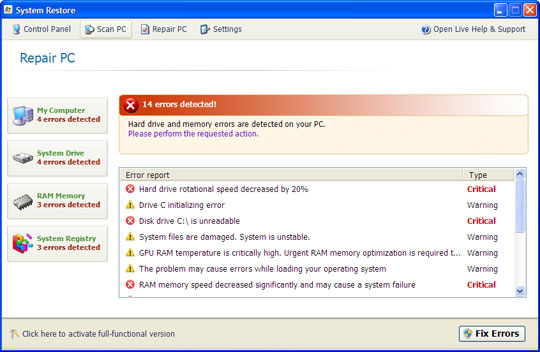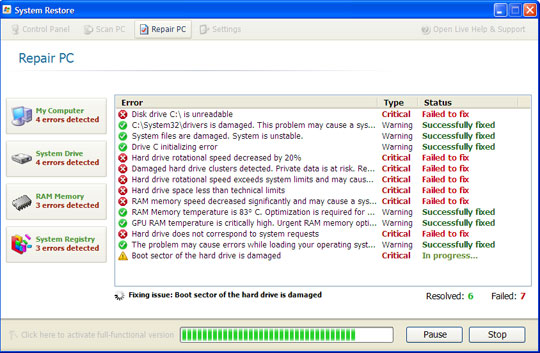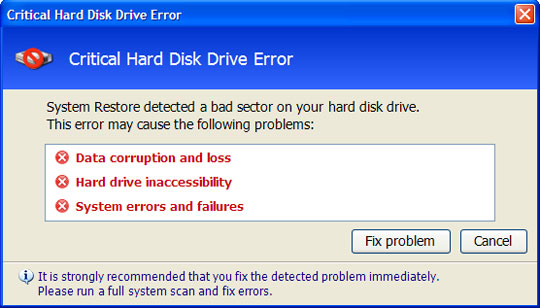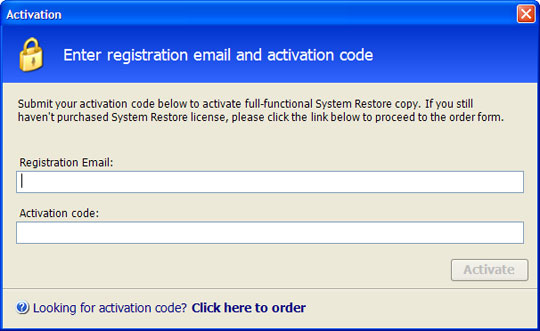TROJ_FAKESYS.AK
Trojan:Win32/FakeSysdef (Microsoft); FakeAlert-SysDef.b (Mcafee); Trojan.Win32.Jorik.Fraud.fbr (Kaspersky); Mal/FakeAV-OP (Sophos)
Windows 2000, Windows XP, Windows Server 2003


Threat Type: Trojan
Destructiveness: No
Encrypted: No
In the wild: Yes
OVERVIEW
This Trojan displays a Graphical User Interface (GUI).
When users agree to buy the software, it connects to a certain URL.
It deletes the initially executed copy of itself.
This Trojan may be dropped by other malware.
It does not have any propagation routine.
It does not have any backdoor routine.
It modifies the Internet Explorer Zone Settings.
It does not have any downloading capability.
It does not have any information-stealing capability.
TECHNICAL DETAILS
349,696 bytes
EXE
Yes
17 Oct 2011
Displays message/message boxes
Arrival Details
This Trojan may be dropped by the following malware:
- TROJ_FAKESYS.AJ
Installation
This Trojan drops the following non-malicious files:
- %System Root%\Documents and Settings\All Users\Application Data\{random filename}
- %User Profile%\Application Data\Microsoft\Internet Explorer\Quick Launch\System Restore.lnk
- %Desktop%\System Restore.lnk
- %Start Menu%\Programs\System Restore\System Restore.lnk
- %Start Menu%\Programs\System Restore\Uninstall System Restore.lnk
(Note: %System Root% is the root folder, which is usually C:\. It is also where the operating system is located.. %User Profile% is the current user's profile folder, which is usually C:\Windows\Profiles\{user name} on Windows 98 and ME, C:\WINNT\Profiles\{user name} on Windows NT, and C:\Documents and Settings\{user name} on Windows 2000, XP, and Server 2003.. %Desktop% is the current user's desktop, which is usually C:\Windows\Profiles\{user name}\Desktop on Windows 98 and ME, C:\WINNT\Profiles\{user name}\Desktop on Windows NT, and C:\Documents and Settings\{User Name}\Desktop on Windows 2000, XP, and Server 2003.. %Start Menu% is the current user's Start Menu folder, which is usually C:\Windows\Profiles\{user name}\Start Menu on Windows 98 and ME, C:\WINNT\Profiles\{user name}\Start Menu on Windows NT and C:\Windows\Start Menu or C:\Documents and Settings\{User name}\Start Menu on Windows 2000, XP, and Server 2003.)
It drops the following copies of itself into the affected system:
- %System Root%\Documents and Settings\All Users\Application Data\{random filename}.exe
(Note: %System Root% is the root folder, which is usually C:\. It is also where the operating system is located.)
It creates the following folders:
- %Start Menu%\Programs\System Restore
(Note: %Start Menu% is the current user's Start Menu folder, which is usually C:\Windows\Profiles\{user name}\Start Menu on Windows 98 and ME, C:\WINNT\Profiles\{user name}\Start Menu on Windows NT and C:\Windows\Start Menu or C:\Documents and Settings\{User name}\Start Menu on Windows 2000, XP, and Server 2003.)
Other System Modifications
This Trojan adds the following registry entries:
HKEY_CURRENT_USER\Software\Microsoft\
Internet Explorer\Main
Use FormSuggest = "Yes"
HKEY_CURRENT_USER\Software\Microsoft\
Windows\CurrentVersion\Internet Settings
WarnOnZoneCrossing = "0"
HKEY_CURRENT_USER\Software\Microsoft\
Windows\CurrentVersion\Internet Settings
WarnonBadCertRecving = "0"
HKEY_CURRENT_USER\Software\Microsoft\
Windows\CurrentVersion\Internet Settings
CertificateRevocation = "0"
Propagation
This Trojan does not have any propagation routine.
Backdoor Routine
This Trojan does not have any backdoor routine.
Web Browser Home Page and Search Page Modification
This Trojan modifies the Internet Explorer Zone Settings.
Download Routine
This Trojan does not have any downloading capability.
Information Theft
This Trojan does not have any information-stealing capability.
NOTES:
Rootkit Capabilities
This malware does not have rootkit capabilities.
Other Details
It displays the following Graphical User Interface (GUI):




When users agree to buy the software, it connects to the following URL to continue the purchase:
- {BLOCKED}igger.com
- {BLOCKED}gs-866650.com
- {BLOCKED}-304200.com
- {BLOCKED}76421.com
- {BLOCKED}tor.com
- {BLOCKED}22866.com
It deletes the initially executed copy of itself
SOLUTION
9.200
8.504.02
17 Oct 2011
8.505.00
18 Oct 2011
Step 1
For Windows XP and Windows Server 2003 users, before doing any scans, please make sure you disable System Restore to allow full scanning of your computer.
Step 3
Identify and terminate files detected as TROJ_FAKESYS.AK
- If the detected file is displayed in either Windows Task Manager or Process Explorer but you cannot delete it, restart your computer in safe mode. To do this, refer to this link for the complete steps.
- If the detected file is not displayed in either Windows Task Manager or Process Explorer, continue doing the next steps.
Step 4
Delete this registry value
Important: Editing the Windows Registry incorrectly can lead to irreversible system malfunction. Please do this step only if you know how or you can ask assistance from your system administrator. Else, check this Microsoft article first before modifying your computer's registry.
- In HKEY_CURRENT_USER\Software\Microsoft\Internet Explorer\Main
- Use FormSuggest = "Yes"
- Use FormSuggest = "Yes"
- In HKEY_CURRENT_USER\Software\Microsoft\Windows\CurrentVersion\Internet Settings
- WarnOnZoneCrossing = "0"
- WarnOnZoneCrossing = "0"
- In HKEY_CURRENT_USER\Software\Microsoft\Windows\CurrentVersion\Internet Settings
- WarnonBadCertRecving = "0"
- WarnonBadCertRecving = "0"
- In HKEY_CURRENT_USER\Software\Microsoft\Windows\CurrentVersion\Internet Settings
- CertificateRevocation = "0"
- CertificateRevocation = "0"
Step 5
Search and delete this folder
- %Start Menu%\Programs\System Restore
Step 6
Search and delete these files
- %System Root%\Documents and Settings\All Users\Application Data\{random filename}
- %User Profile%\Application Data\Microsoft\Internet Explorer\Quick Launch\System Restore.lnk
- %Desktop%\System Restore.lnk
Step 7
Reset Internet security settings
Step 8
Scan your computer with your Trend Micro product to delete files detected as TROJ_FAKESYS.AK. If the detected files have already been cleaned, deleted, or quarantined by your Trend Micro product, no further step is required. You may opt to simply delete the quarantined files. Please check this Knowledge Base page for more information.
Did this description help? Tell us how we did.

